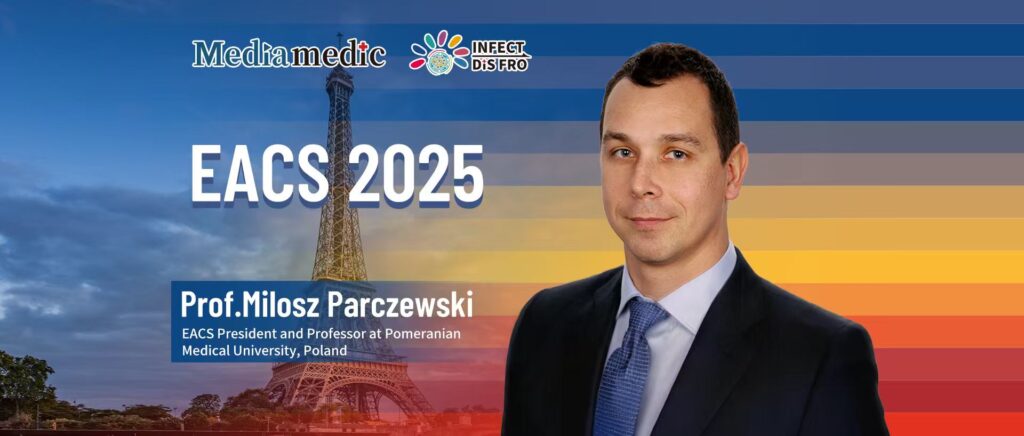
The 20th European AIDS Clinical Society (EACS) Conference (EACS 2025) officially commenced on October 15, 2025, in Paris, France. Under the theme "From Science to Implementation," the conference aims to bridge cutting-edge research and clinical advancements with actionable policies to advance global HIV/AIDS prevention and care. Infectious Medicine Today had the privilege of interviewing Prof. Milosz Parczewski, EACS President and Professor at Pomeranian Medical University, Poland, on-site in Paris. He shared insights into the conference's highlights, EACS's contributions to HIV/AIDS management, and key updates in the latest EACS guidelines.Prof. Milosz Parczewski
Pomeranian Medical University, Szczecin, Poland
Miłosz Parczewski has received the MD diploma at the Pomeranian Medical University, Szczecin, Poland in 2002 and was granted a Ph.D diploma in molecular epidemiology of HIV in 2007 and a title of professor of medicine in 2016 based on the scientific publications on HIV resistance and transmission networks. He is the current President of European AIDS Clinical Society for the term 2025-2027 and the National Consultant for Infectious Diseases, appointed in 2023.Between 2017 to 2024, Miłosz was the President of the Polish Scientific AIDS Society, and is currently also Council Member for the European Society on Antiviral Resistance, associate editor of BMJ STI and HIV Medicine journals. Currently he is leading the Department of Infectious, Tropical Diseases and Acquired Immunodeficiency Pomeranian Medical University, Szczecin, Poland. His research focuses on the molecular epidemiology in HIV infection and HCV coinfection, phylogenetics and migration.
IDF: Thank you for accepting our invitation. And could you introduce yourself first to the Chinese audiences?
Prof. Milosz Parczewski: I’m Miłosz Parczewski. I’m a professor of medicine, a specialist in infectious diseases, and also the current European AIDS Clinical Society President. So, thank you.
IDF: Infect As the president of EACS 2025, could you highlight the key features and standout sessions of this year’s conference?
Prof. Milosz Parczewski: This year we have a very broad conference highlighting many features,
starting from basic science, multiple clinical tracks, and also prevention. As you could see, we’ve got oral presentations, we’ve got meet-the-expert sessions, we’ve got parallel sessions, we’ve got thematic presentations, moderated e-posters, and posters. So, it’s an extensive conference.
The prevention and clinical part focuses on the novelty in clinical medicine, in dual-acting regimens, in long-acting injectables, both in prevention and care. We have also introduced this year for the first time a co-chair selection session, where we have selected the primary science of a big importance, including the efficacy of novel antiretroviral agents, but also comorbidities and, for example, reactivation of Hepatitis B. So, we’ve got a really interesting and extensive program. There have been also a significant number of late-breaker science presented, which shows not only the clinical science but also social science and stigma across communities, including the trans community. So there is something for basically everyone, from basic science, clinical, prevention, and social science tracks.
IDF: Could you please introduce the role of EACS in promoting AIDS prevention, treatment, and scientific research in Europe and even globally?
Prof. Milosz Parczewski: EACS is deeply committed to fostering collaboration across Europe—and indeed beyond. We work not only within the European region but also partner with societies and networks in other parts of the world, including Asia. This global outlook is a key part of our mission.
With this year’s conference themed “From Science to Implementation,” we’ve placed a stronger emphasis on prevention and on translating research into real-world impact. We’re also increasingly involved in policy advocacy—especially important at a time when funding for HIV-related programs is being cut in many regions. Our goal is to support people living with HIV and those at risk of acquisition, even in challenging financial and political environments.
We engage with governments to promote policies that advance pre-exposure prophylaxis (PrEP) and access to new therapies. We also invest in education—training early-career scientists and clinicians in the latest developments in HIV care, with a focus on marginalized and hard-to-reach populations, including migrants.
Importantly, we prioritize women’s health. We have a very dynamic movement within EACS called WAVE (Women Against Viruses in Europe) which aims to promote the welfare of women living with HIV in Europe. They’ve just held a major workshop before the kickoff of the EACS conference.
IDF: What do you see as the most critical scientific research questions that still need to be addressed in the future fight against HIV/AIDS?
Prof. Milosz Parczewski: So, if we consider HIV and AIDS and the progress in scientific research
on these issues, there are several key points to address.
First, let’s focus on prevention. The critical question is how to implement novel agents equitably across populations—not restricting access to only countries that can afford them, but extending it to Africa, and crucially for us, to Central and Eastern Europe and Asia, where the HIV epidemic is actually expanding. This is the first implementation-related question. Additionally, we need to examine the efficacy of novel pre-exposure prophylaxis (PrEP) agents across a diverse landscape of HIV subtypes and varying resistance patterns. This is the second preventive question that I consider highly important.
Next, from the perspective of clinical care: What will be the exact efficacy of novel agents across different populations? What risks will be associated with their use? What measures will be needed to prevent other comorbidities and hepatitis? As we progress along the continuum of care, we must also consider aging populations, comorbidities, and the rising prevalence of sexually transmitted infections (STIs). Therefore, responding to the accumulation of comorbidities and the spread of STIs across populations is of primary importance.
Lastly, there is the issue of collaboration. We need to determine how to strengthen and promote collaborations with the community, with individuals at risk of HIV, and with people living with HIV. This also lies at the heart of our research questions.
IDF: You presided over the discussion on this EACS guideline. In which areas do you think the new edition of the EACS guideline has significant updates, and what changes in the concept of HIV prevention and treatment do they reflect?
Prof. Milosz Parczewski: So, as you have seen and notably pointed out, we are releasing a major update—the 13th update. Firstly, significant work has been done to enhance the clarity and ease of access to our guidelines. The entire panel for accessing the guidelines has been redesigned to be clearer and more user-friendly.
Regarding major updates, we need to consider current antiretroviral treatment options, prevention strategies, comorbidities, and the treatment of opportunistic infections. So, you really need to read through the sections to see what has been implemented. We have made numerous major adjustments to make the guidelines clearer and also updated them in accordance with the current guidelines available across other specialties.

